
Itinerary of Etruria's green gold, among the Tuscan hills that hold relics and evidence of the Etruscan world
In Etruria olive oil was produced in large quantities and then traded throughout the Mediterranean; probably also used to cook, it was widely employed in other settings: on religious occasions to light the lamps in sanctuaries, for lighting in homes and public and private buildings, in the medical field as a painkiller, and in the aesthetic sphere to perfume skin and hair. Numerous oil-based perfumed essence containers have been found and displayed in museums in Tuscan towns.
Starting with the Barberino Tavarnelle area, moving on to Cortona and finally Sarteano, it is not difficult to grasp the soul of the past and, at every corner, breath in the Etruscan presence. The following stages, thanks to the unique items preserved in the various museums, accompany you on a special journey amidst the findings, traditions and curiosities of the Etruscan food and farming culture and in the use of oil in various aspects of daily life. All around, olive trees surround the towns and dominate the hills, making up the typical Tuscan landscape along with vineyards, then as now.

Chianti, a region that needs no presentation and is known throughout the world, is not only an excellent wine. The very hills that offer their famous nectars and highly prized extra virgin olive oil have yet more to offer: a millennial history rooted in Etruscan times. Etruscan artefacts have been found in the Barberino Tavarnelle area, and in particular in the areas of Sant’Appiano, San Martino ai Colli and Semifonte, such as Attic ceramics and decorated funerary containers made of alabaster; with a highly valuable but not extensive archaeological collection preserved in the Antiquarium, the archaeological museum is housed in the rooms of the evocative parish church of Sant'Appiano.
Leaving the Florentine hills behind and moving to those of Arezzo, the horizon continues to be punctuated by gentle, sinuous hills, where olive groves alternate with vineyards and thousand-year-old towns dominate the surrounding territories. Lands crossed by the ancient river Clanis of central Etruria that today go by the name of Valdichiana. A valley with an incredibly rich Etruscan heritage. The beautiful town of Cortona with the MAEC, the Etruscan Academy Museum of the City of Cortona, and Castiglion Fiorentino with its Civic Archaeological Museum, house veritable archaeological treasures of Etruscan origin from the surrounding archaeological areas, first and foremost the stunning Etruscan chandelier of the MAEC.
Important Etruscan testimonies have also emerged from the alluring towns of Civitella in Val di Chiana, Monte San Savino, Foiano della Chiana, Lucignano, and their adjoining territories, including several well preserved tombs.

The Val di Chiana and its precious Etruscan heritage continues in the Sienese territory with the magnificent towns of Montepulciano and Sinalunga, but above all the city of Chiusi, the ancient Etruscan lucumonia (religious city state) of Clevsin, which preserves notable testimonies such as the Tomb of the Monkey, the so-called Labyrinth of King Porsenna and many other valuable finds in its National Archaeological Museum.
Straddling the Sienese Val di Chiana and the Val d'Orcia, other towns and the enchanting countryside surrounding them offer opportunities to enjoy the magnificent landscape and learn more about the Etruscan world.
The Giancarlo Pallavicini Archaeological Collection of Trequanda exhibits a valuable collection of various trousseaus and furnishings of Etruscan origin, while the Civic Archaeological Museum of Sarteano preserves artefacts found in the surrounding necropolises, and in particular displays a life-size reproduction of the Tomb of the Infernal Chariot (Tomba della Quadriga Infernale), a monumental tumulus excavated in the travertine which preserves one of the few examples of Etruscan painting and is open to the public.